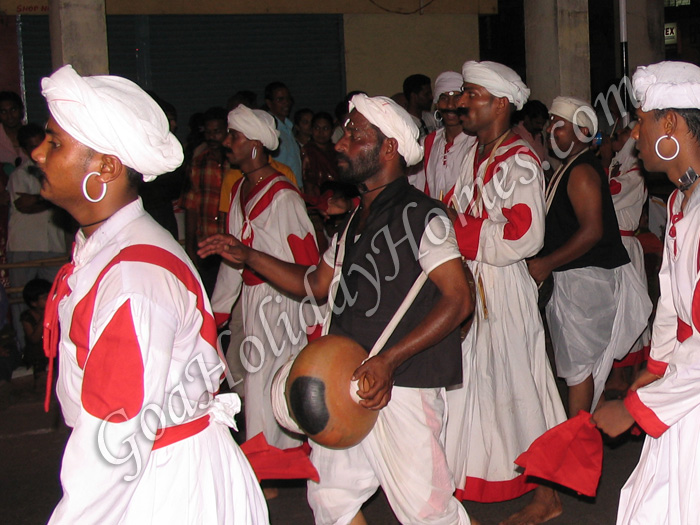GOAN FOLK DANCES
Many castes, sub-castes and tribes mingled in its social texture in Goa’s long history and this presents a wide diversity of folk arts that incarnate its traditions, customs, convictions and culture.
Goan folk dances bear a tradition of thousands of years, characterized by innumerable forms performed by and reflecting lifestyles, cultures and aspirations of different strata, religions and caste of Goan society.
The prominent ones include Corredinho Dance, Dekhni Dance, Dhalo Dance, Dhangar Dance, Fugdi Dance, Ghode Modni, Goff
DanceDance, Kunbi Dance, Lamp Dance, Mussal dance and Romal Dance.
GHODE MODANI
This is the name of a splendid ho folk dance that is mainly performed in Bicholim Taluka of Goa. The dances brangs back the memory of the great warriors in the past. The dancers swing around with dummy horses tucked to their waists. They carry swords in their hands showcasing bravery and at the same time they wear 'ghungrus'. The background music is the music of dhol and tasha.
MANDO
Mondo refers to the various love songs that are enriched by capturing each and every emotion. These are folk songs that came into existence with the Goan aristocracy. The starting of these songs reflect the sad state of mind but the rhythm they acquire in the end is named as dulpod. A blend of Indian and Western traditions can be found in these songs. The contemporary songs belonging to this category present varied and distinct emotions and therefore, they are difference from the old compositions such as bhajan, arti, dasarwadem, etc.
DEKHNI DANCE
Dekhni is referred as a song cum dance. This is because the song has western bearings while the dance is of Indian form. It is only the women dancers who conduct this beautiful dance. A film producer got so enchanted by a popular Dekhni song that he made it familiar to every child of the country. Whenever this dance is performed, it is done with ghumat.
GOFF TALGADI AND SHIGMO
They are awesome and beautiful folk dances that are a part of Spring jubilation and they are basically performed to spread festive mood and happiness among the peasants. These dances are mainly performed by peasants of Goa. The peasants residing in Canacona Taluka perform the Goff dance. Goff consists of weaving of braid with various tints. The entire dance is a symbol of extreme discipline. Talgadi is also a folk dance that is performed on ghumat beats. It is quite identical to the dandiya dance of Gujarat. Shigmo is a dance that is performed by wearing colorful dresses and is done of the beats of dhol, tasha, cymbals, etc.
DHANGAR DANCE
Hangars form a community of shepherds who worship a folk god named as Bira Deva. They believe in rituals and various celebrations. They celebrate with dances on dhol and flute. The dances they perform are usually dedicated to Shri Radha and Krishna. The costumes they were are named as Kathiawari white dress.
MUSSAL KHEL
This is one of the folk inheritances that involve a song cum dance done in the praise of brave kings. An important aspect associated with this dance is that it is performed by Christians to praise a Hindu King. The main day when the dance is performed is the beautiful full moon day of falguna month of the Hindu calendar. It is basically performed by the Cholas of Chandor who were defeated by the Harihar of Vijaynagar dynasty.
ZAGOR
Zagor is a folk dance inherited from the Modern Marathi Theatre in Goa. It consists of two formsone of which belongs to the Pernni community, while the other belongs to the Christian Gawdas. Pernni Zagor concentrates on the philosophical topics based on the origin of universe. On the other hand the Christian Gawdas has been taken from the contemporary village life.
LAMP DANCE
This kind of lamps uses brass lamps and it is unique and difficult since it is basically the art and skill of the dancer who keeps the lamp on his head and uses different body movements without affecting the position of the lamp. The time at which this dance is performed is the time of the Shigmo festival. The various instruments that are used for this kind of dance are Cymbal, Ghumat, Haronium, and Samel. The songs used are the traditional folk songs and the main regions wherein this dance is performed are the southern and central regions of Goa.
FUGDI AND DHALO
These folk dances are basically performed by women and they are quite common. The pace of Dhalo is slow while that of while that of Fugdi is fast. The pattern followed by the Fugdi dance is circular and in Dhalo a dozen of women dance having their faces in front of each other. Both these folk dances are performed on Marathi and Konkani song.
KUNBI DANCE
Kunbi dance is a tribal folk dance of the Kunbi community of Goa that portrays social themes. The dance is simple in its presentation and is performed during various social occasions
Kunbi dance is usually performed by the women folk. The movements are fast yet graceful. The dancers perform the steps very elegantly. Kunbi dance is performed solely on social occasions.
Their songs and dance belonging to the pre-Portuguese era are uniquely social and not religious. An example of a Kunbi song: "The coy bride is filling the pitcher in the ankle-deep water of the rivulet and the fish (called) Thigur is winking at her." The dancers tie their hair in a neat bun and adorn it with colourful decorative flower garlands. They also wear simple jewelleries which usually comprises of necklace, earrings and bangles.
Conclusion:
Traditional art forms such asfolk dance are not usually considered to have much relevance to an understanding of social change. ... Still folk dance, being a group activity, is often popularly conceived as having its origins in communal spontaneity and creativity, rather than in individual composition.


